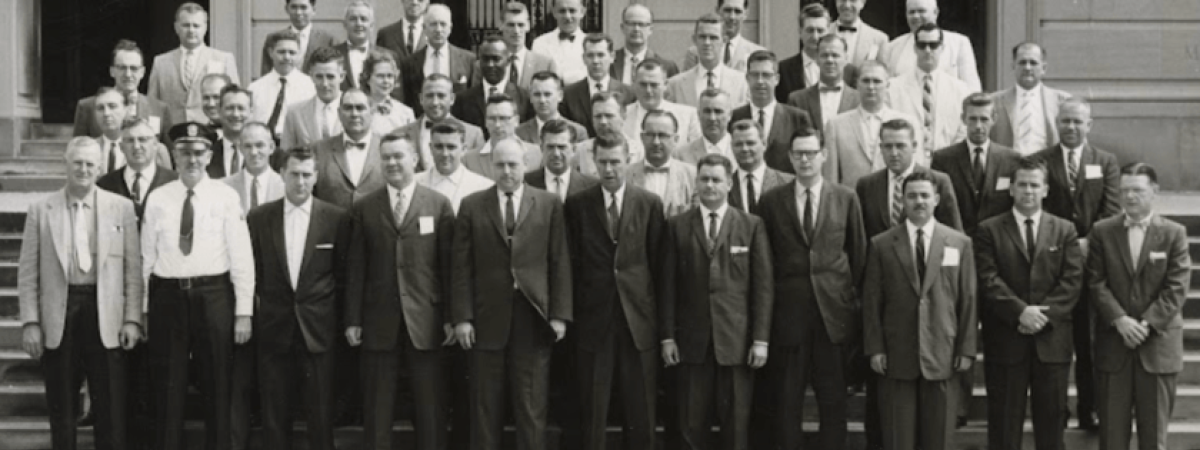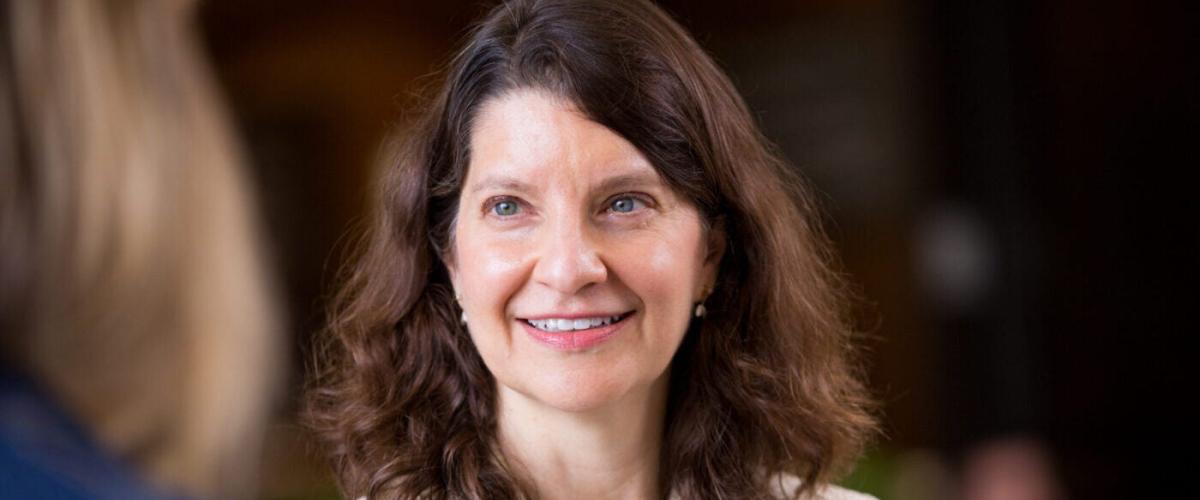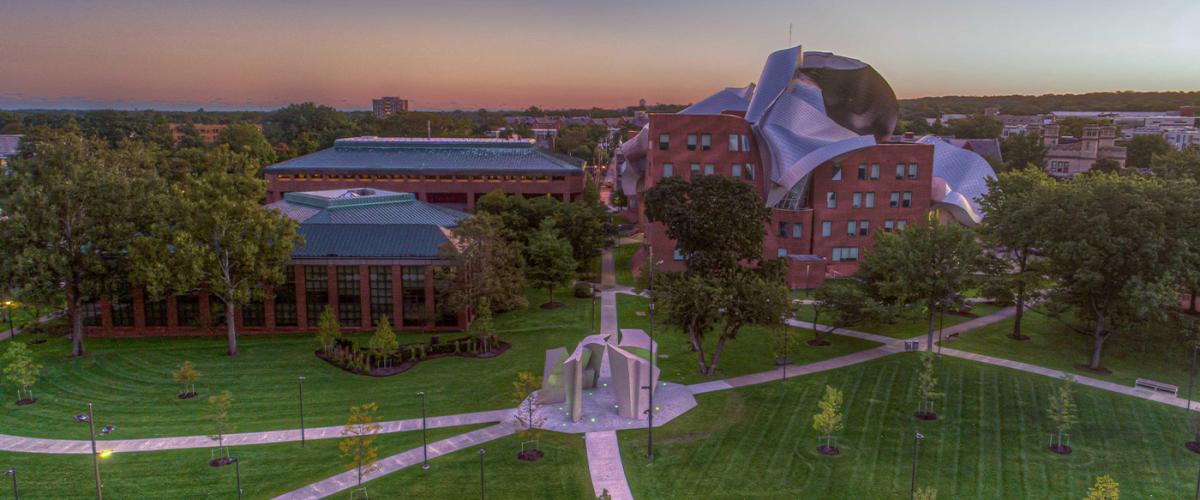Law-Medicine Center celebrates 70 years of shaping the field
In the years leading up to the Law-Medicine Center’s founding in 1953, the Cleveland city morgue was nothing like the crisp white laboratory setting of today. Built in 1895, it had no scientific instruments, no modern examination tables, and no medical professionals. Coroners at the time were elected officials with no formal training, and in the morgue, bodies lay shrouded in white sheets, cigar smoke and the smell of whiskey.
This unscientific setting could ultimately lead to miscarriage of justice, recalled Alan Moritz, MD, then chief pathologist at the city’s Lakeside Hospital, in a 1983 magazine article. Based on his experience with the Cleveland police force, he knew that the outcome of a case could be decided for or against a defendant based on evidence gathered from a thorough examination of a deceased person’s body. With lives hanging in the balance, he felt that medical science should be crucial knowledge for legal professionals—so in 1953, Moritz teamed with Western Reserve University law professor Oliver Schroeder (ADL ’38) and county coroner Samuel Gerber to found the university’s Law-Medicine Center, the first of its kind in the United States.
For the next three decades, the new center largely focused on forensics and criminal law, serving as a training ground for coroners, judges, attorneys and police officers, said Max Mehlman, its current co-director. “In those days,” he noted, “if you tried to find a parking place near the law school, you would often find all the streets lined with police cars because so many officers were taking the courses.”
By 1986, however—when Mehlman took over as director from Schroeder—the legal/medical world had become far more byzantine than ever before, filled with cases more complex than its founders could ever have anticipated. New scientific advances such as genetic engineering, which was previously the stuff of science fiction, loomed on the horizon.
“It was clear to me when I first started here that the center needed to shift its focus. Instead of covering the role of medicine in law, we needed to effectively turn things upside down and focus on the role of law in medicine,” Mehlman said. “In other words, how does law affect the practice and delivery of medical care?”
Mehlman’s view of the future was prescient. Since the 1980s, medical progress has developed at a dizzying rate: gene therapies are now treating previously deadly diseases with ease; artificial intelligence has enabled scientists to analyze their data at record speeds; patients can visit with doctors via telemedicine; and biotechnology has advanced to the point where researchers can now make a vaccine for a novel virus in a matter of months. Sharona Hoffman, who joined the faculty in 1999 and is now Mehlman’s co-director, noted that each of these breakthroughs has raised its own legal and bioethical questions. The center’s research and publications are at the vanguard of many of these issues. Moreover, the center trains students to anticipate potential problems before they arise.
“We teach students to think critically about the next big scientific or medical advancement as it emerges because there may or may not be legislation or regulation to guide them,” Hoffman said. “If you educate them well, they can hopefully recognize a potential privacy or discrimination problem in a new technology. They’ll know to always think, ‘Well, are there any downsides? Is this going to disadvantage minorities or people who are not wealthy? Are there unintended consequences we’re not taking into account?’”
Expanding views
The ability to anticipate and address those problems is no small feat, but the center’s in-house expertise goes a long way toward preparing students to meet those challenges. In addition to Mehlman and Hoffman, six other faculty members now provide insights on fields as diverse as environmental law, reproductive rights, human trafficking, LGBTQ+ issues, nursing home care, clinical ethics, informed consent, public health law and drug regulation.
Visiting scholars offer valuable perspectives on a variety of other areas: The Law-Medicine Center formally hosts several guest lecturers each year to discuss topics on the leading edge of the legal and medical fields and share their views with an audience of faculty, staff, students and the public. Likewise, the center’s Schroeder Scholar-in-Residence program (named after the center’s founder) invites legal and health experts to take part in classes, workshops and public remarks, many of which are published each year in the center’s prestigious student-edited journal, Health Matrix.
Health Matrix, which was first published in the early 1990s, is now ranked the third best law-medicine journal in the world by Washington and Lee’s Journal Rankings. It is both an important resource for health law scholars and a key learning tool for students. Hoffman works closely with its editors, advising and mentoring all those who have a hand in its publication—providing experience that reinforces their education in ways that they might not have expected.
“It’s given me the chance to edit sophisticated pieces of health law and policy and read perspectives that I probably would not have covered in my normal studies. Sometimes, [the work shows] a new viewpoint on particular issues, which has helped me better understand complex topics as a whole,” said Corey Whetzel, a third-year student and the journal’s current editor-in-chief. “Seeing how someone is formulating their opinion based on the law gives it a different dynamic than someone just stating their personal opinion with no authority to back that up. It allows for a greater understanding of where someone else is coming from.”
Real-world impact
The desire to make a tangible difference is something the center routinely brings out in its students, and there are few places it shines brighter than in its Health Law Clinic. Since its creation in the early 1990s, it has offered a space for hands-on practice, effectively becoming a public interest law firm within the school that focuses on underserved communities.
“Today, we have a two-pronged goal: One is to serve a need in the community and provide high quality-legal representation to our neighbors. The other is to train law students, and expose them to the issues that consumers of our healthcare system confront on a daily basis,” said Laura McNally, associate dean for experiential education at the School of Law and director of the Milton and Charlotte Kramer Law Clinic.
McNally, who also oversees the Health Law Clinic, works closely with third-year students to offer free legal counsel to the public, whether it’s through one-day pop-up clinics or longer trial work in which students represent clients from start to finish. This year, her primary focus for the clinic is Social Security benefits hearings—cases in which clients are facing a loss of financial support.
Although those cases may seem like mundane administrative battles, McNally said they are a dense microcosm of the sorts of skills students need to succeed in the field of medical law. To provide effective representation, students must be able to review and understand medical evidence, prepare direct cross-examination of both their client and medical experts, conduct opening and closing arguments, and write a formal brief for every case.
“During the semester that students spend in the clinic, they’ll work about 20 hours a week on a single case,” she said. “They’re often quite the foe in court and other places because they have more time to spend on these cases than other practitioners. They can dig and dig and turn over rocks that wouldn’t normally be turned over for their clients.”
As the Law-Medicine Center enters its eighth decade it strives to continue to be at the forefront of contemporary health law challenges as it pertains to research, service and teaching. Graduates go on to work in vastly different areas of the law—public interest organizations, in-house counsel for drug companies, advising elected officials or regulatory agencies—but no matter which path they take, their work has the potential to fundamentally change lives for the better.
“We will continue to produce timely scholarship and programming that influence both academics and policy-makers,” said Hoffman. “Our students will have much to contribute to the future of the field.”



.png)
.png)


